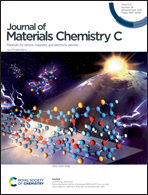Electropolymerization of poly(spiroBiProDOT) on counter electrodes for platinum-free dye-sensitized solar cells†
Abstract
A better replacement of electrocatalytic platinum on counter electrodes of dye-sensitized solar cells (DSSCs) has received increasing attention to achieve a balance between efficient charge transfer and cost-effectiveness. Using an electrochemical polymerization method, a polymeric layer of poly(2H,2′H,4H,4′H-3,3′-spirobi[thieno[3,4-b][1,4]dioxepine]), called poly(spiroBiProDOT), was fabricated on a fluorine-doped tin oxide (FTO) counter electrode. For comparison, poly(3,4-ethylenedioxythiophene), called PEDOT, a polymer layer and Pt were also deposited on the FTO counter electrode. Photovoltaic characterizations of the fabricated solar cells based on poly(spiroBiProDOT), PEDOT, and Pt counter electrodes were performed, and maximum power conversion efficiencies of 7.9%, 6.8%, and 8.31% were achieved, respectively. Poly(spiroBiProDOT) exhibits a stronger competitiveness to replace Pt in comparison with PEDOT. The competitiveness mainly comes from the better charge transfer in poly(spiroBiProDOT) due to its ordered thiophene moiety connected by a spiro linkage, which can increase the photocurrent density, and therefore, the cell efficiency. Electron density calculation, microstructural characterization, and impedance analysis were performed to rationalize the better efficiency of poly(spiroBiProDOT).



 Please wait while we load your content...
Please wait while we load your content...